The displacement of a particle is represented by the equation y=3cos(π4−2ωt).
The motion of the particle is
simple harmonic with period 2π/ω
simple harmonic with period π/ω
periodic but not simple harmonic
non-periodic
The correct Answer is:B
Step by step video, text & image solution for The displacement of a particle is represented by the equation y=3cos((pi)/(4)-2omegat). The motion of the particle is by Physics experts to help you in doubts & scoring excellent marks in Class 12 exams.
Updated on:21/07/2023Similar Questions
Knowledge Check
The displacement of a particle is represented by the equation y=3cos(π4−2ωt).
The motion of the particle isAsimple harmonic with period 2π/ωBsimple harmonic with period π/ωCperiodic but not simple harmonicDnon-periodThe displacemtn of a particle is represented by the equation y=3cos(π4−2ωt).
The motion of the particle isAsimple harmonic with period 2π/ωBsimple harmonic with periodπ/ωCperiodic but not simple harmonicDnon-periodicThe displacement of a particle is represented by the equation y=sin3ωt. The motion is
Anon-periodicBperiodic but not simple harmonicCsimple harmonic with period 2π/ωDsimple harmonic with period pπ/ω
The displacement of a particle is represented by the equation
y=0.4{cos2(πt2)−sin2(πt2)}metre
The motion of the particle is
View SolutionA particle move along y-axis according to equation y+3+4cosωt. The motion of the particle is
View SolutionThe displacement of a particle is given by x=cos2ωt. The motion is
View Solutionparticle is executing the motion x=Acos(ωt−θ) The maximum velocity of the particle is
View SolutionA xandy co-ordinates of a particle are x=Asin(ωt)andy=Asin(ωt+π/2). Then, the motion of the particle is

View Solution
